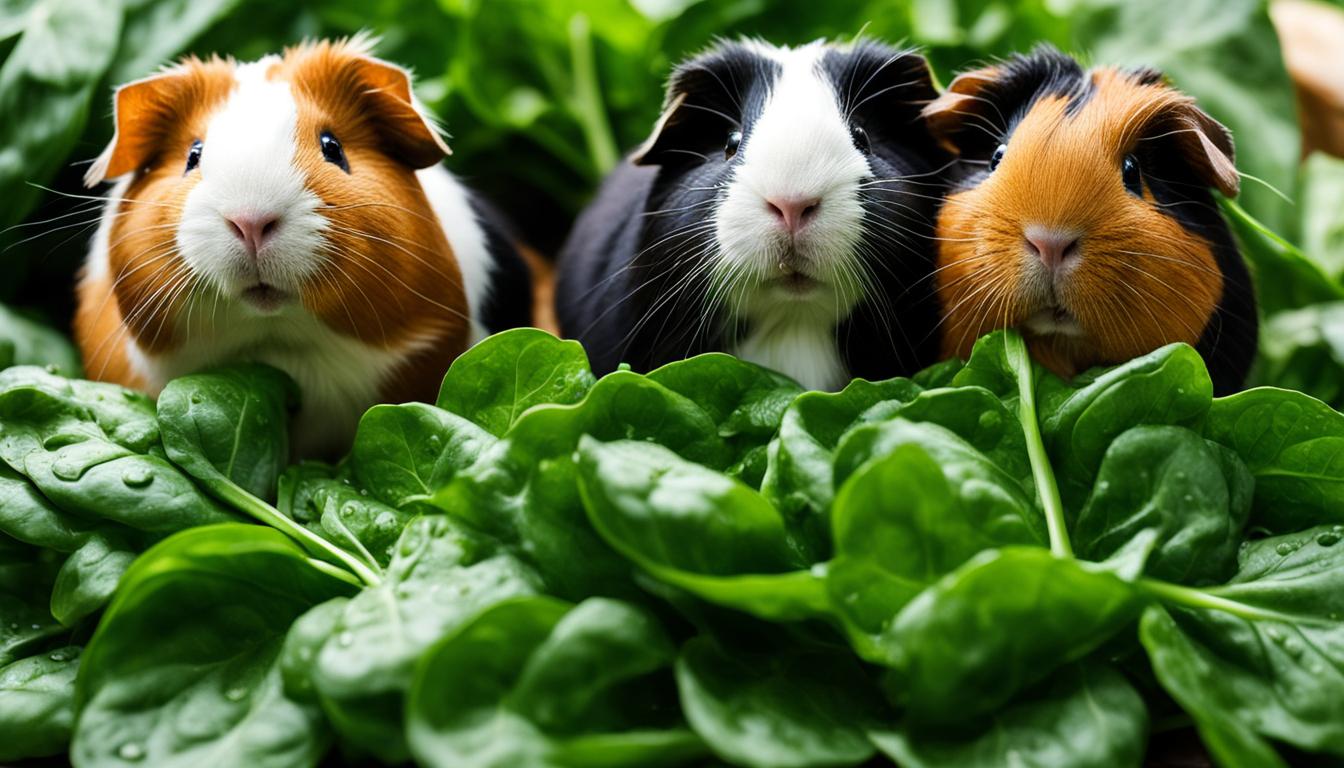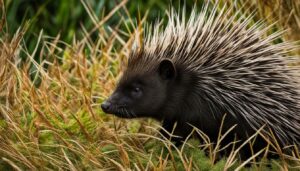As responsible pet owners, we always want to ensure that our furry friends are getting the best nutrition possible. When it comes to guinea pigs, their diet plays a crucial role in their overall health and well-being. One common question that arises is whether guinea pigs can eat spinach. Let’s explore this topic and provide you with the necessary information to make informed decisions about your guinea pig’s diet.
Key Takeaways:
- Guinea pigs can eat spinach, but it should be limited due to its high calcium and oxalate content.
- Guinea pigs require a balanced diet that includes pellets, hay, and fresh vegetables.
- Leafy greens such as romaine lettuce, red and green leaf lettuces, mustard or turnip greens, cabbage, kale, cilantro, and parsley should make up the majority of their fresh produce.
- Consulting with a veterinarian is essential to ensure that your guinea pig’s diet is appropriate and helps maintain their health.
- Avoid feeding high-starch foods, spoiled or unwashed food items to guinea pigs.
The Role of Grass Hay in a Guinea Pig’s Diet
Grass hay plays a crucial role in the diet of guinea pigs. Not only does it provide necessary fiber for their digestive system, but it also helps to wear down their continuously growing teeth. Grass hay should make up approximately 80% of a guinea pig’s daily food intake, ensuring optimal health and well-being.
When it comes to choosing hay, there are several options available. Timothy hay and orchard hay are excellent choices for adult guinea pigs, as they are lower in calories and calcium. These types of hay provide the necessary roughage without the risk of excessive weight gain or urinary issues. On the other hand, younger guinea pigs require more calcium for their growing bones, making alfalfa hay a suitable option for them.
It’s essential to ensure that the hay provided is fresh, clean, and free from dust or mold. Guinea pigs have sensitive respiratory systems, and inhaling dusty hay can lead to respiratory problems. Additionally, hay should be stored in a cool, dry place to maintain its nutritional value and prevent spoilage. By incorporating the right type of grass hay into your guinea pig’s diet, you can help promote their overall health and digestive function.
Choosing the Right Commercial Food for Guinea Pigs

When it comes to providing a well-balanced diet for your guinea pigs, choosing the right commercial food is essential. Guinea pig pellets are a convenient and nutritionally complete option that can be supplemented with hay and fresh vegetables. Here, we’ll discuss the key considerations in selecting the best guinea pig pellets for your furry friends.
It’s important to opt for vitamin C-fortified pellets specifically designed for guinea pigs. Vitamin C is an essential nutrient for these small animals, as they cannot produce it on their own. Look for pellets that have been fortified with vitamin C to ensure your guinea pigs are getting an adequate amount in their diet. Avoid pellets with added seeds or dried fruit, as these can be high in fat and sugar, which are not suitable for guinea pigs.
When determining the portion size of pellets, around 1/8 cup per guinea pig, supplemented with hay and fresh vegetables, is sufficient. Remember to buy smaller portions of pellets to maintain the effectiveness of the vitamin C content. Over time, the vitamin C in pellets can degrade, so it’s important to feed them within their expiration date to ensure maximum nutritional benefits.
Table: Comparing Guinea Pig Pellets
| Brand | Vitamin C Content | Ingredients |
|---|---|---|
| Brand A | 100 mg/kg | Timothy hay, soybean hulls, wheat middlings, soybean meal |
| Brand B | 200 mg/kg | Alfalfa hay, corn, soybean meal, wheat middlings |
| Brand C | 150 mg/kg | Timothy hay, alfalfa meal, soybean meal, flaxseed |
This table compares three popular guinea pig pellet brands, showcasing their vitamin C content and key ingredients. It’s essential to consider the nutritional needs of your guinea pigs when selecting a brand. While all three options provide vitamin C, the specific content may vary. Additionally, it’s important to check the ingredients list, ensuring they align with your guinea pigs’ dietary requirements.
Incorporating Fresh Vegetables into a Guinea Pig’s Diet

When it comes to providing a well-balanced diet for your guinea pig, fresh vegetables play a crucial role. These leafy greens not only add variety and flavor to their meals but also provide important nutrients to keep them healthy and happy.
Here are some fresh vegetables that you can include in your guinea pig’s diet:
- Red leaf lettuce
- Green leaf lettuce
- Mustard greens
- Turnip greens
- Cabbage
- Kale
- Cilantro
- Parsley
These leafy greens are rich in vitamins and minerals, and they offer a variety of flavors and textures for your furry friend to enjoy. It is recommended to offer a mixture of these vegetables to provide a balanced diet.
Including Fruit as Occasional Treats for Guinea Pigs

Adding a variety of fruits to your guinea pig’s diet can be a delightful way to offer them occasional treats. While fruits are generally high in sugar and should be given in small portions, they also contain important nutrients like vitamin C, which is essential for guinea pigs. Some suitable fruits for guinea pigs include:
- Orange: A small wedge of orange can provide a refreshing burst of flavor and vitamin C for your furry friend.
- Apple: A thin slice of apple, without seeds or the core, can be a crunchy and nutritious treat.
- Blueberries: Several blueberries can be offered to guinea pigs, as they are packed with antioxidants and vitamin C.
- Banana: A thin slice of banana is a sweet treat that guinea pigs enjoy. Bananas are also a good source of vitamin C.
When offering fruits to your guinea pig, remember to consider portion sizes. It is important to provide small amounts of fruit, as their high sugar content can cause digestive issues if consumed excessively. Aim for about one small portion of fruit per day or several times a week to keep your guinea pig’s diet balanced.
| Fruit | Nutritional Benefits |
|---|---|
| Orange | High in vitamin C, boosts immunity |
| Apple | Provides fiber and vitamins |
| Blueberries | Rich in antioxidants and vitamin C |
| Banana | Good source of potassium and vitamin C |
Foods to Limit or Avoid in a Guinea Pig’s Diet

When it comes to feeding your guinea pig, it’s important to be aware of the foods that should be limited or avoided altogether. Certain foods can have negative effects on their health, including the risk of bladder stones and digestive issues. Let’s take a closer look at the high-calcium foods, high-oxalate foods, and high-starch foods that should be approached with caution.
High-Calcium Foods
Foods that are high in calcium should be limited in a guinea pig’s diet as they can increase the risk of bladder stones. Some examples of high-calcium foods include kale, chard, and broccoli. While these vegetables can be a part of your guinea pig’s diet, they should be given in moderation. Too much calcium can lead to the formation of stones in their bladder or urinary tract, which can be painful and require veterinary intervention.
High-Oxalate Foods
Oxalates are naturally occurring compounds found in certain foods that can hinder calcium absorption and contribute to the formation of bladder stones. Vegetables like cabbage, bok choy, Brussels sprouts, and spinach are high in oxalates and should be limited in a guinea pig’s diet. While spinach can be fed to guinea pigs occasionally, it should not be a regular part of their diet due to its high oxalate content.
High-Starch Foods
Foods that are high in starch should be avoided in a guinea pig’s diet as they can cause digestive issues. High-starch foods include bread, cereal, corn, and peas. Guinea pigs have delicate digestive systems, and foods high in starch can lead to bloating, gas, and discomfort. It’s best to stick to their primary diet of hay, pellets, and fresh vegetables to ensure their digestive health.
Lastly, it’s essential to avoid feeding your guinea pig spoiled or unwashed food items. Moldy or spoiled food can cause serious health issues, including digestive problems and even poisoning. Always ensure that the food you offer to your guinea pig is fresh, clean, and safe for consumption.
| Food Type | Foods to Limit or Avoid |
|---|---|
| High-Calcium Foods | Kale, chard, broccoli |
| High-Oxalate Foods | Cabbage, bok choy, Brussels sprouts, spinach |
| High-Starch Foods | Bread, cereal, corn, peas |
By being mindful of the foods to limit or avoid in your guinea pig’s diet, you can help promote their overall health and well-being. Remember to provide a balanced diet that includes hay, pellets, and fresh vegetables in appropriate portions. If you have any concerns or questions about your guinea pig’s nutritional needs, it’s always best to consult with a veterinarian.
Conclusion
In conclusion, it is important to maintain the health of your guinea pig by choosing an appropriate diet. Providing a balanced combination of hay, pellets, and fresh vegetables is essential for their well-being. By following these guidelines, you can prevent medical complications and ensure their overall health.
When determining the right diet for your guinea pig, it is always a good idea to consult with a veterinarian. They will have the knowledge and expertise to help you make informed decisions about your pet’s nutritional needs. A veterinarian can also provide specific recommendations based on your guinea pig’s age, breed, and any special dietary requirements they may have.
Remember, while guinea pigs can eat spinach, it should be fed in moderation due to its calcium and oxalate content. Keeping their diet well balanced and varied will help prevent issues like bladder stones. By prioritizing your guinea pig’s health and consulting with a professional, you can ensure that they lead a happy and healthy life.
FAQ
Can guinea pigs eat spinach?
Yes, guinea pigs can eat spinach, but it should be limited due to its high calcium and oxalate content.
What should be the main component of a guinea pig’s diet?
Grass hay, such as timothy or orchard hay, should make up around 80% of a guinea pig’s diet.
What kind of pellets should I feed my guinea pig?
Guinea pigs should be given timothy-based vitamin C-fortified pellets without seeds or dried fruit added.
How often should I offer fresh vegetables to my guinea pig?
Fresh vegetables can be offered once a day, totaling 1/2 to 1 cup per guinea pig.
Can guinea pigs eat fruit?
Yes, fruit can be offered to guinea pigs as an occasional treat, about once a day or several times a week.
What foods should I limit or avoid in a guinea pig’s diet?
Foods high in calcium, such as spinach, kale, and chard, should be limited. High-starch foods like bread and corn should be avoided.
How can I maintain my guinea pig’s health through its diet?
Providing a balanced diet that includes pellets, hay, and fresh vegetables, and consulting with a veterinarian can help maintain your guinea pig’s health and prevent complications.




